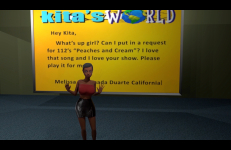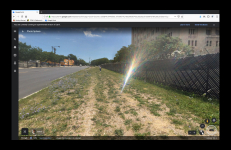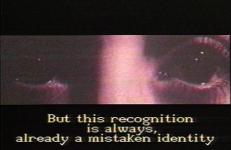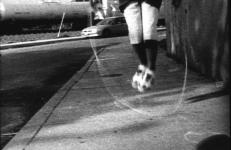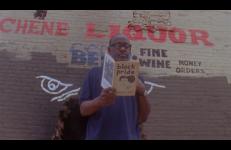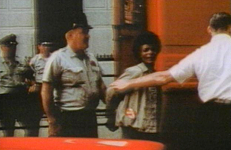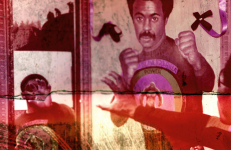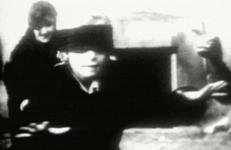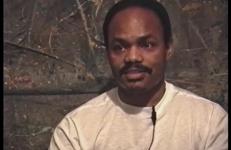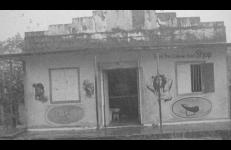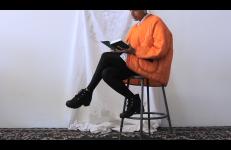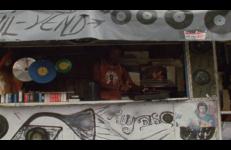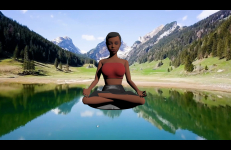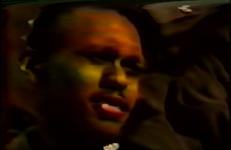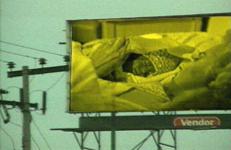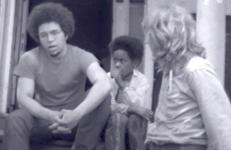Dream Nightmare is from Martine Syms’ Kita’s World series. Kita enacts the performances of everyday life in a hyper-digitized world. The character’s roles range from meditation guru to cultural commentator, and she speaks directly to questions of consciousness within the systems of labor, race, technology, and institutional failure. To the cognitive dissonance of Siri mishearing her speech, to the terror of (mis)representation, to the instinct to reconnect with nature.
Race
Frenzied voices on the Chicago Police Department’s scanner call for squad cars and reprisals during the 2020 uprising in response to the murders of George Floyd, Breonna Taylor, and Ahmaud Arbery, as Google Earth tracks the action through simulated aerial views of urban spaces and the vast Cook County Department of Corrections, the country’s third-largest jail system. In Christopher Harris’s Dreams Under Confinement, the prison, and the street merge into a shared carceral landscape.
In this meditation on contemporary race relations, two black men discuss in voiceover certain “casual” events in life and cinema that are unnoticed or discounted by whites — gestures, hesitations, stares, off-the-cuff remarks, jokes — details of an ideology of repressed racism.
This title is also available on Tony Cokes Videoworks: Volume 1.
Fifeville is a film about a neighborhood in Charlottesville, Virginia. It focuses on the details, gestures, and material life of the citizens of Fifeville as they communicate their understandings of the neighborhood’s changing landscape. Although Fifeville is set in Charlottesville, it could be Any Black Community Experiencing Gentrification, USA, 21st Century.
Co-director: Corey D.B. Walker. Crew: bh103a.
Fluid Frontiers is the fifth and final film in the series entitled The Diaspora Suite, exploring Asili’s personal relationship to the African Diaspora. Shot along the Detroit River, Fluid Frontiers explores the relationship between concepts of resistance and liberation, exemplified by the Underground Railroad, Broadside Press, and artworks of local Detroit Artists.
In the words of activist Dhoruba Bin Wahad, “Historical and social events are subject to almost instant censorship by those who have better access and control over the medium of communication. It is important that there exist people skilled in the use of the technological instruments of communication who will seek out the real truth behind the headlines and tell it for all to see, know, and hear.”
In the words of activist Dhoruba Bin Wahad, “Historical and social events are subject to almost instant censorship by those who have better access and control over the medium of communication. It is important that there exist people skilled in the use of the technological instruments of communication who will seek out the real truth behind the headlines and tell it for all to see, know, and hear.”
The Videofreex conducted this interview with Fred Hampton, the Deputy Chairman of the Illinois chapter of the Black Panther Party, in October 1969, just over a month before he was killed by the Chicago police.
Using footage from the legendary Bruce Lee’s last, unfinished, film, Fulbeck turns the subtitled martial arts movie on itself—levelling criticism and commentary with the genre's own tools, and examining the various representative functions of the late actor.
Go-Rilla Means War is a filmic relic of gentrification featuring 35mm film salvaged from a now demolished Black Civil Rights Theater in Bedford-Stuyvesant, Brooklyn. After finding the film unfinished and un-canned on the floor of The Slave Theater, Campbell collaborated with the unknown director (presumably amateur filmmaker Judge John Phillips who owned the Slave Theater) to finish the film.
In The Great Mojado Invasion (The Second US - Mexico War), writer/performer Guillermo Gómez-Peña and filmmaker Gustavo Vazquez combine Chicano wit and political vision to create an ironic, post-millennial and postmodern look at the future of U.S./Mexican relations. Both artist and director generate a complex commentary on history, society, pop culture, the politics of language and the repercussions of ethnic dominance.
In The Great Mojado Invasion (The Second US - Mexico War), writer/performer Guillermo Gómez-Peña and filmmaker Gustavo Vazquez combine Chicano wit and political vision to create an ironic, post-millennial and postmodern look at the future of U.S./Mexican relations. Both artist and director generate a complex commentary on history, society, pop culture, the politics of language and the repercussions of ethnic dominance.
A formidable collage of striking images, this powerful and provocative work confronts racial violence through images of ecological mayhem, machismo, pornography, and Third World poverty — images which return to the taboo body of a black man. "Directed and produced by our culture," An I for An I studies how violence is internalized and psychologized by overlapping soundtracks, printed texts, recurrent images, doctored footage and split screens. The piece attacks racist culture and pleads for an alternative recourse to violence.
In The Blood is an experimental documentary about American-Jewish attitudes towards Germans, and the role the Holocaust plays in shaping Jewish identity. This layered collage combines appropriated images, original footage, sampled sounds, and fragments of audio conversations, to examine perceptions and representations of Germany, cultural identity, collective memory, and history.
Featuring Ken and Louise from Wendy Clarke's One on One video series, this video exchange encompasses a shared passion for music and pure emotional vulnerability that creates an incredibly intimate relationship between these two strangers throughout the project's evolution. Their connection is palpable, leaving the viewer envisioning a possible real life encounter between the two outside of the realm of this project.
Sections 1-30 of an incomplete extended poem describing the artist's connection to the radical black tradition. The completed poem will be formed of 180 sections.
"Lessons are all about constraints; they are thirty seconds, must feature a black figure, and I have rules about where to make cuts, how to edit sound, etc."
— Martine Syms in conversation with Aram Moshayedi, Mousse Magazine
Sections 31-60 of an incomplete extended poem describing the artist's connection to the radical black tradition. The completed poem will be formed of 180 sections.
"Lessons are all about constraints; they are thirty seconds, must feature a black figure, and I have rules about where to make cuts, how to edit sound, etc."
— Martine Syms in conversation with Aram Moshayedi, Mousse Magazine
The Diaspora Suite
Filmed on location in Salvador, Brazil (the last city in the Western Hemisphere to outlaw slavery) and Harlem, NY ( an international stronghold of the African Diaspora), Many Thousands Gone draws parallels between a summer afternoon on the streets of the two cities. A silent version of the film was given to jazz multi-instrumentalist Joe McPhee to use an interpretive score. The final film is the combination of the images and McPhee’s real time “sight reading” of the score.
Meditation is from Martine Syms’ Kita’s World series. Kita enacts the performances of everyday life in a hyper-digitized world. The character’s roles range from meditation guru to cultural commentator, and she speaks directly to questions of consciousness within the systems of labor, race, technology, and institutional failure. To the cognitive dissonance of Siri mishearing her speech, to the terror of (mis)representation, to the instinct to reconnect with nature.
Memory Palace is a short video grounded in the personal history of the artist. A discovery of a photo album activates memories of physical spaces, which in turn open doors to reminiscences of past family life. Inspired by the classical method of loci, the film presents a woman — singer/songwriter Alice Smith — at work in Los Angeles.
In the case of Carlos Motta’s career, the impetus has always been on, not adhering to particular medium or a particular style, but rather using media as it becomes appropriate tell a story that has heretofore been stifled by dominant power structures. The technical variability of his work is only matched by its potential to generate conversation and discourse in the arenas of sexuality, gender, democracy and colonialism – usually as a conflux of all four through historical excavation.
My Only Idol is Reality is a video work created from an excerpt of Season One of MTV’s The Real World. The piece uses repetition as a framework for abstraction — re-recording the video between
This is a video of musical terror where I superficially — this is the beginning of a larger project —l look at one of the Mexican phenomena that horrifies me the most: internalized racism, being ashamed of one's own roots. The fantasy of waking up white.
— Ximena Cuevas
Skip Blumberg of the Videofreex conducts an interview with Charles “Cappy” Pinderhughes, the Lieutenant of Information of the New Haven branch of the Black Panther Party. From the steps of the New Haven headquarters, Cappy publicizes the upcoming Revolutionary Peoples Constitutional Convention set to take place in Washington, D.C. later that week (June 19th, 1970). In addition, Cappy provides a statement to be shared via the Videofreex at the Alternative Media Conference occurring at Godard College in Vermont.




